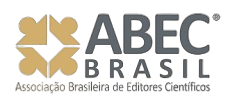Submissions
Submission Preparation Checklist
All submissions must meet the following requirements.
- The text is formatted with 1.5 space; uses a 12-point font; uses italics instead of underlining (except URL addresses); figures and tables are inserted in the text, not at the end of the document in the form of attachments.
- The contribution is original and unpublished, and is not being evaluated for publication by another journal; otherwise, it must be justified in "Comments to the editor".
- The text follows the style standards and bibliographic requirements described in Submission, on the About the Journal page.
- The submission file is in Microsoft Word, OpenOffice or RTF format. URLs for referrals were provided when possible.
- It is recommended that at least one of the authors has a doctorate/PhD. Reviews, interviews and translations may be authored by graduates.
Artigos
Os artigos deverão ser inéditos. Poderão submeter artigos, entrevistas e traduções para publicação doutorandos, mestres e doutores em História ou áreas afins; mestrandos poderão publicar artigos, entrevistas e traduções em co-autoria com o orientador, bem como submeter resenhas individualmente. As traduções devem vir acompanhadas de autorização do autor e do original do texto.
Os artigos terão a extensão de 15 a 22 páginas em formato A4, digitadas em fonte Times New Roman 12, com espaço 1,5, incluindo tabelas, gráficos, figuras e notas. Deve conter título (em português e em inglês); nome do(a) autor(a), seguido por nota de rodapé com titulação, vinculação institucional, projeto vinculado, endereço para correspondência (e-mail). As citações de mais de três linhas deverão ser feitas em destaque, com fonte 11 e recuo 2,5 cm. Margens: superior e esquerda: 3,0 cm; inferior e direita: 2,0 cm. Os artigos serão acompanhados do resumo e abstract em inglês, de no máximo 10 linhas, e 3 palavras-chave. Titulo, e palavras- chave também dever ter versão em inglês.
As referências bibliográficas completas devem ser listadas em ordem alfabética, no final do artigo. Quando citada, a obra deve ser indicada de maneira simplificada, seja no corpo do artigo, seja em nota explicativa, no sistema autor/data/página(s): (Autor, ano, p.nnn); ou, se autor citado no texto, data e página (2015, p.nn)
As notas devem ser colocadas no final do texto, ou notas explicativas, desde que imprescindíveis, não superior a 20.
Normatização das notas conforme NBR 6023:
Livro: SOBRENOME, Nome. Título do livro em itálico: subtítulo. Tradução. Edição. Cidade: Editora, ano. nnnp.
Capítulo ou parte de livro: SOBRENOME, Nome. Título do capítulo ou parte do livro. In: SOBRENOME, Nome (Org.) Título do livro em itálico: subtítulo. Tradução. Edição. Cidade: Editora, ano. p.xxx-yyy.
Artigo em periódico: SOBRENOME, Nome. Título do artigo. Título do periódico em itálico, Cidade: Editora, v.xx, n.xx, p.xxx-yyy, ano.
Trabalho acadêmico: SOBRENOME, Nome. Título em itálico: subtítulo. Dissertação/Tese (Mestrado/Doutorado em ...) – Unidade, Instituição. Cidade, ano.
Texto obtido na internet: SOBRENOME, Nome. Título. Data (se houver). Disponível em: www...; Acesso em: dd mmm. ano.
Trabalho apresentado em evento: SOBRENOME, Nome. Título do trabalho. In: NOME DO EVENTO, número (se houver), ano, Local do evento. Anais... Local: Editora (se houver), ano. p.xxx-yyy.
Artigos, traduções, entrevistas e resenhas devem ser apresentados conforme os modelos para formatação de artigos e resenhas a serem encaminhados para Fronteiras. Apresentados fora do modelo, serão devolvidos para adequação. Traduções devem vir com nota explicativa contendo todas as informações do texto traduzido.
Traduções
Poderão submeter artigos, entrevistas e traduções para publicação doutorandos, mestres e doutores em História ou áreas afins; mestrandos poderão submeter resenhas individualmente. As traduções devem vir acompanhadas de autorização do autor e do original do texto.
As traduções terão a extensão de 15 a 22 páginas em formato A4, digitadas em fonte Times New Roman 12, com espaço 1,5, incluindo tabelas, gráficos, figuras e notas. Deve conter título (em português e em inglês); nome do(a) autor(a), seguido por nota de rodapé com titulação, vinculação institucional, projeto vinculado, endereço para correspondência (e-mail).
As citações de mais de três linhas deverão ser feitas em destaque, com fonte 11 e recuo 2,5 cm. Margens: superior e esquerda: 3,0 cm; inferior e direita: 2,0 cm. Os artigos serão acompanhados do resumo e abstract em inglês, de no máximo 10 linhas, e 3 palavras-chave. Titulo, e palavras- chave também dever ter versão em inglês.Fontes e margens seguem mesmas normas dos artigos.
As referências bibliográficas completas devem ser listadas em ordem alfabética, no final do artigo. Quando citada, a obra deve ser indicada de maneira simplificada, seja no corpo do artigo, seja em nota explicativa, no sistema autor/data/página(s): (Autor, ano, p.nnn); ou, se autor citado no texto, data e página (2015, p.nn)
As notas devem ser colocadas no final do texto, ou notas explicativas, desde que imprescindíveis, não superior a 20.
Normatização das notas conforme NBR 6023:
Livro: SOBRENOME, Nome. Título do livro em itálico: subtítulo. Tradução. Edição. Cidade: Editora, ano. nnnp.
Capítulo ou parte de livro: SOBRENOME, Nome. Título do capítulo ou parte do livro. In: SOBRENOME, Nome (Org.) Título do livro em itálico: subtítulo. Tradução. Edição. Cidade: Editora, ano. p.xxx-yyy.
Artigo em periódico: SOBRENOME, Nome. Título do artigo. Título do periódico em itálico, Cidade: Editora, v.xx, n.xx, p.xxx-yyy, ano.
Trabalho acadêmico: SOBRENOME, Nome. Título em itálico: subtítulo. Dissertação/Tese (Mestrado/Doutorado em ...) – Unidade, Instituição. Cidade, ano.
Texto obtido na internet: SOBRENOME, Nome. Título. Data (se houver). Disponível em: www...; Acesso em: dd mmm. ano.
Trabalho apresentado em evento: SOBRENOME, Nome. Título do trabalho. In: NOME DO EVENTO, número (se houver), ano, Local do evento. Anais... Local: Editora (se houver), ano. p.xxx-yyy.
In memoriam Américo Augusto da Costa Souto
Resenhas
Poderão submeter artigos, entrevistas e traduções para publicação doutorandos, mestres e doutores em História ou áreas afins; mestrandos poderão submeter resenhas individualmente. As traduções devem vir acompanhadas de autorização do autor e do original do texto.
As resenhas devem ter entre 3 e 5 páginas. Fontes e margens seguem mesmas normas dos artigos. Devem referir-se a livros nacionais publicados no mesmo ano ou no ano anterior ao da submissão, ou livros estrangeiros publicados nos últimos quatro anos.
As referências bibliográficas completas devem ser listadas em ordem alfabética, no final do artigo. Quando citada, a obra deve ser indicada de maneira simplificada, seja no corpo do artigo, seja em nota explicativa, no sistema autor/data/página(s): (Autor, ano, p.nnn); ou, se autor citado no texto, data e página (2015, p.nn)
As notas devem ser colocadas no final do texto, ou notas explicativas, desde que imprescindíveis, não superior a 20.
Artigos, resenhas e traduções, quando publicadas, devem indicar data de recebimento e aprovação: Ex: Artigo/Resenha recebida em 14 de dezembro de 2015. Aprovada em 23 de dezembro de 2015.
Normatização das notas conforme NBR 6023:
Livro: SOBRENOME, Nome. Título do livro em itálico: subtítulo. Tradução. Edição. Cidade: Editora, ano. nnnp.
Capítulo ou parte de livro: SOBRENOME, Nome. Título do capítulo ou parte do livro. In: SOBRENOME, Nome (Org.) Título do livro em itálico: subtítulo. Tradução. Edição. Cidade: Editora, ano. p.xxx-yyy.
Artigo em periódico: SOBRENOME, Nome. Título do artigo. Título do periódico em itálico, Cidade: Editora, v.xx, n.xx, p.xxx-yyy, ano.
Trabalho acadêmico: SOBRENOME, Nome. Título em itálico: subtítulo. Dissertação/Tese (Mestrado/Doutorado em ...) – Unidade, Instituição. Cidade, ano.
Texto obtido na internet: SOBRENOME, Nome. Título. Data (se houver). Disponível em: www...; Acesso em: dd mmm. ano.
Trabalho apresentado em evento: SOBRENOME, Nome. Título do trabalho. In: NOME DO EVENTO, número (se houver), ano, Local do evento. Anais... Local: Editora (se houver), ano. p.xxx-yyy.
Relatos
Serão publicados na seção Relatos, textos com relatos de vivencia, pesquisa ou atividades voltadas à prática da História ou áreas afins – que dialoguem com o escopo da Fronteiras: Revista Catarinense de História.
Privacy Statement
The names and addresses informed in this magazine will be used exclusively for the services provided by this publication, and will not be made available for other purposes or to third parties.


















